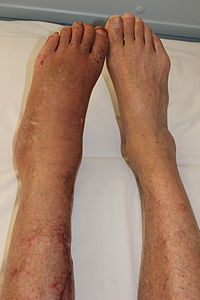
Photo from wikipedia
Background Cold hypersensitivity (CH) is a sensation of cold in the limbs and (or) body of a patient in an environment that is not considered cold by unaffected people, or… Click to show full abstract
Background Cold hypersensitivity (CH) is a sensation of cold in the limbs and (or) body of a patient in an environment that is not considered cold by unaffected people, or a strong feeling of cold at a relatively low temperature. However, the currently available treatments are limited and often unsatisfactory. This study aimed to evaluate the clinical efficacy and safety of the sympathetic radiofrequency thermocoagulation (RF-TC) technique in patients with CH disorder. Methods The study is a retrospective analysis. A total of 71 were entered into the final analysis and all patients underwent computed tomography-guided thoracic (lumbar) sympathetic nerve RF-TC on an elective basis. The values of terminal temperature (T) and perfusion index (PI) of patients before and after treatment were recorded. Patients were followed up clinically at regular intervals and their Visual Analog Scale (VAS) and Pittsburgh Sleep Quality Index (PSQI) scores were recorded to detect postoperative complications and assess patient satisfaction with the treatment. Results All patients completed the radiofrequency treatment. Compared with the preoperative period, VAS and PSQI scores were significantly lower at all postoperative time periods (P < 0.001). Patients had significantly higher postoperative terminal temperatures and perfusion indices on the right and left sides than before surgery (P < 0.001). The overall patient satisfaction score was 4 (3–5) at 3 years of postoperative follow-up. There were 20 recurrences (28.2%). The main postoperative complications were postoperative local pain and compensatory hyperhidrosis. No other adverse events or deaths were observed. Conclusion RF-TC for CH could be a feasible, effective, and safe treatment option to improve patients' symptoms of cold sensation. Yet, more researches are needed to verify this potentially efficient and standardized treatment.
Journal Title: Frontiers in Neurology
Year Published: 2022
Link to full text (if available)
Share on Social Media: Sign Up to like & get
recommendations!